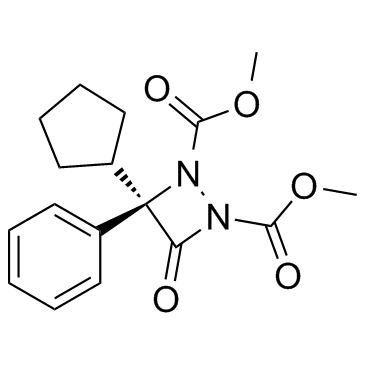1073529-41-5
| Name | ABL127 |
|---|---|
| Synonyms |
1,2-Diazetidine-1,2-dicarboxylic acid, 3-cyclopentyl-4-oxo-3-phenyl-, dimethyl ester, (3R)-
Dimethyl (3R)-3-cyclopentyl-4-oxo-3-phenyl-1,2-diazetidine-1,2-dicarboxylate MFCD28053514 ABL127 |
| Description | ABL127 is a selective and covalent inhibitor of protein methylesterase 1 (PME-1) with IC50s of 6.4 nM and 4.2 nM in HEK293T and MDA-MB-231 cells, respectively. |
|---|---|
| Related Catalog | |
| Target |
IC50: 6.4 nM (PME-1 in HEK293T), 4.2 nM (PME-1 in MDA-MB-231)[1] |
| In Vitro | Three described PME-1 inhibitors are tested in this assay and a thermal shift with 100 μM ABL127 is detected. Using 25 or 50 μM ABL127 also shows a shift in protein melting temperature. It is found that treatment of Ishikawa cells with ABL127 and AMZ-30 significantly decreases cell proliferation similarly to depletion of PME-1 with shRNA. It is also found that treatment of ECC-1 cells with ABL127 or AMZ-30 affects cell invasion in a dose-dependent manner. The treatment of EC cells with ABL127 leads to a significant ~45 % increase in protein phosphatase 2A (PP2A) activity, while treatment with AMZ-30 leads to a modest ~10 % increase in PP2A activity[1]. |
| In Vivo | No significant decrease in tumor burden can be assessed in these pilot studies[1]. Gel-based profiles indicate that brain PME-1 is inactivated by ABL127, but overlapping serine hydrolase activities preclude a confident assessment of the extent of inactivation[2]. |
| Kinase Assay | Human PME-1 protein lacking the last three amino acids (PME-1des3) is purified from Sf9 cells. The assay is completed by first conducting a 10 min pre-incubation of 1 μM PME-1des3 with 100 μM ABL127, 100 μM AMZ-30, 100 μM EHT, or vehicle (0.05 % DMSO) in the presence of SYBR Orange (1:1000, v/v) at 37°C in 1× NEB buffer 2 (50 mM NaCl, 10 mM Tris-HCl, 10 mM MgCl2, 1 mM DTT, pH 7.9 at 25 °C); a thermal gradient is performed increasing temperature by 2°C per minute increments from 37 to 95°C, and fluorescence (492 to 610 nm) is acquired on a thermal cycler[1]. |
| Cell Assay | Cells are subjected to 5 μg/mL puromycin selection for 10 to 14 days and are clonally expanded. Validated clones are incubated with media and compounds (including ABL127) for the indicated times for phenotypic assays[1]. |
| Animal Admin | ECC-1 cells are subcutaneously inoculated into the flanks of female SCID mice and are allowed to grow until tumors reached ~400 mm3. A single intratumoral dose of ABL127 diluted in 10% DMSO/PBS is administered. The highest concentration tested is 5 mg/kg of ABL127 due to poor solubility of the compound[1]. |
| References |
| Density | 1.3±0.1 g/cm3 |
|---|---|
| Boiling Point | 422.8±48.0 °C at 760 mmHg |
| Molecular Formula | C17H20N2O5 |
| Molecular Weight | 332.351 |
| Flash Point | 209.5±29.6 °C |
| Exact Mass | 332.137207 |
| LogP | 2.78 |
| Vapour Pressure | 0.0±1.0 mmHg at 25°C |
| Index of Refraction | 1.586 |
| RIDADR | NONH for all modes of transport |
|---|
